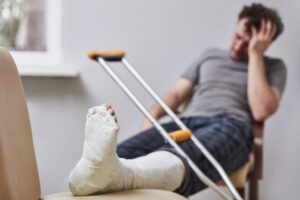Have you suffered an injured leg in a hospital as a visitor? Are you wondering if you could make a public liability claim? This article not only focuses on compensation for a public liability claim but who could be eligible to pursue such a case.
We have included examples of the types of accidents that could happen within a hospital setting and how these could result in a visitor suffering an injury to their leg. When pursuing any type of personal injury claim, it is vital to be able to support your case with evidence to improve its chances of success, therefore, we look at what you could gather as proof.
We can answer any questions you may have about a potential claim if you’ve injured your leg in a hospital, as well as inform you of the benefits of having assistance from one of the No Win No Fee solicitors from our panel.
Get in touch today using any of the methods below, or carry on reading for more information.
- Call on 0161 696 9685
- Contact us via our website
- Use the pop-up chat window
Select A Section
- Examples Of Payouts For An Injured Leg In A Hospital
- Are You Eligible To Claim For An Injured Leg In A Hospital?
- Examples Of Accidents Causing Leg Injuries In A Hospital
- Showing The Hospital Was Liable For Your Injuries
- No Win No Fee Public Liability Claims?
- Read More About Injury Claims For Public Place Accidents
Examples Of Payouts For An Injured Leg In A Hospital
If you make a successful public liability claim for an injured leg in a hospital, you will be awarded a compensation settlement that could consist of up to two Heads of Loss: general damages and special damages.
General damages account for the pain and suffering caused by leg injuries. There are various resources available to those responsible for making the necessary calculations to arrive at a figure suitable for you to receive. One of these is a publication called the Judicial College Guidelines (JCG).
We’ve included some example figures in the table below that have been taken from the latest edition of the JCG, which was last updated in 2022. These figures are guidelines only. Your own circumstances will influence how much your own general damages payment is worth.
| Injury | Severity | Notes | Amount |
|---|---|---|---|
| Multiple severe injuries plus financial losses. | Severe | Injuries of a serious nature affect different parts of the body and lead to substantial financial losses such as costs for home adaptations and at home care fees plus a loss in earnings. | Up to £500,000+ |
| Leg | (a) Amputation (iv) | An amputation below the knee has taken place. | £97,980 to £132,990 |
| Leg | (b) Severe (i) | These injuries are very severe, but fall just short of requiring amputation. | £96,250 to £135,920 |
| Leg | (b) Severe (ii) | Very serious injuries that result in permanent issues with mobility. Extensive treatment and recovery time will be necessary, and crutches will be needed for the rest of the claimant's life. | £54,830 to £87,890 |
| Leg | (b) Severe (iii) | Serious injuries such as a compound fracture with extensive scarring. | £39,200 to £54,830 |
| Leg | (b) Severe (iv) | These injuries will be of moderate severity. For instance, the leg will be fractured in multiple places or severely crushed. | £27,760 to £39,200 |
| Leg | (c) Less serious (i) | For example, serious soft tissue injuries. Another example would be an incomplete recovery from a fracture. | £17,960 to £27,760 |
| Leg | (c) Less serious (ii) | No damage to articular surfaces, but there will be a simple fracture of the femur. | £9,110 to £14,080 |
The top entry of the table is not an excerpt from the JCG.
Further Examples Of Damages
Special damages are the other head of claim that you could be eligible to receive. This figure is calculated to account for the financial impact of your injuries. Here are some examples of what could be included in a special damages payment:
- Loss of earnings.
- Medical expenses.
- Walking Aids.
- Prosthetic Limbs.
- Damage to personal property.
- Care at home.
- Adaptations to your property.
Make sure you hold onto evidence, such as receipts and payslips, to help support this area of your claim. If you’ve injured your leg in a hospital, get in touch with our advisors today for a free valuation.
Are You Eligible To Claim For An Injured Leg In A Hospital?
The Occupiers’ Liability Act 1957 places a duty of care on all occupiers who have control of a public space. This duty means that the occupier must take steps to keep visitors to their space reasonably safe.
For you to have an eligible public liability claim for an injured leg in a hospital, you must be able to satisfy the following criteria:
- Duty of care – You need to be able to prove that, at the time of your injury, you were owed a duty of care by the hospital. Even if you are not a patient, you are still owed this duty. For example, you could be visiting a loved one.
- Breach of duty – This is when the duty of care is not upheld in some way. For instance, there could be a wet floor with no wet floor sign erected within a reasonable amount of time to warn visitors of the slipping hazard.
- Harmed caused – The lack of a wet floor sign could lead to you slipping in a spillage and injuring your leg.
When a duty of care is breached that causes harm to a person that could have otherwise been avoided, this is known as negligence in tort law, for which the person could make a personal injury claim for.
Time Limits On Public Accident Claims
For a public liability claim, you will generally have 3 years from the date you were injured to begin legal proceedings. This time limit can be found in the Limitation Act 1980. However, there are also exceptions to this time limit that are featured in the very same Act.
Get in touch with our advisors if you want to know if you’re still within the limitation period in which you can begin a claim.
Examples Of Accidents Causing Leg Injuries In A Hospital
There are various scenarios that could lead to an injury in a hospital. Here we have provided some illustrative examples to give you some idea of how a duty of care could be breached and lead to an injured leg at a hospital:
- Trailing electrical wires have been left strewn across a hospital corridor. You fail to see the wires, and your foot gets caught, causing you to trip and fall heavily on your leg. You suffer a femur fracture as a result.
- The cleaner forgets to put the wet floor warning signs out after mopping the hospital cafeteria, you walk into the space, you slip, landing very badly on your shin, fracturing your tibia in several places.
- The hospital is made aware of a broken chair in the waiting room. This chair is not removed or replaced, as you sit down, the chair breaks, crushing your leg. You suffer multiple crush injuries to one leg.
Every claim is unique due to the fact that the nature and severity of the injury will vary on a case-by-case basis. As well as the physical damage, you could also sustain psychological injuries, which are accounted for when your compensation is being calculated.
Showing The Hospital Was Liable For Your Injuries
To have an eligible public liability claim against a hospital the onus will be on you to be able to prove why the hospital was responsible for the injury you have suffered. Not all accidents that happen within a public space will mean that the occupier is at fault, so it is vital that you have evidence to support what you are claiming.
Although it’s not exhaustive, we’ve compiled a list below of a few examples of evidence it can be helpful to gather:
- Your medical records – You could also present the hospital discharge letter you receive when you leave the facility after treatment.
- Witness contact information – Others may have seen how you were injured. If so, you should collect their contact information and pass it on to your solicitor. Your solicitor can then approach the witnesses for a statement.
- Video evidence – Check to see if the hospital has CCTV. If it does, and you appear in the footage, you have the right to request a copy.
- Photographs – Take pictures of your injuries and the hazards that led to your accident.
Part of the claims process also involves you being examined by an independent medical professional to establish the severity of your injuries. For more information on how you can support a claim for an injured leg in a hospital, speak with our advisors today.
No Win No Fee Public Liability Claims
All of the solicitors on our panel work with a Conditional Fee Agreement (CFA) in place. A CFA is a form of No Win No Fee arrangement, and it enables you to fully access a solicitor’s legal services without paying them anything upfront.
Following a successful claim, your solicitor is then entitled to take a legally capped percentage of your compensation. This is called a success fee. As the name implies, it is not taken if your claim fails.
How To Contact A Specialist Solicitor
We’re available for free advice on a 24/7 basis. If we think you could have a valid claim, we may also be able to connect you with a No Win No Fee solicitor from our panel.
For a free valuation today, get in touch:
- Call on 0161 696 9685
- Contact us via our website
- Use the pop-up chat window
Read More About Injury Claims For Public Place Accidents
The links below will take you to extra resources you may find helpful.
More from us:
- An accident in a public place can also lead to head injury claims. Read about instances such as these in this guide of ours.
- A public place accident could also lead to an ankle injury claim. Read this for more information.
- This is our guide on arm injury claims, which could also arise from an accident in a public place.
Information from other sources:
- It can be possible to appoint a litigation friend to claim on another’s behalf. For instance, this may be required if the claimant is under 18.
- There is a Pre-Action Protocol when making a claim for an injury in a public place.
- A broken leg is just one example of a leg injury you could sustain. Read about it in this NHS guide.
Thank you for taking the time to read this guide about claiming for a leg injury in a hospital. For any more information, please do not hesitate to call our advisors.



